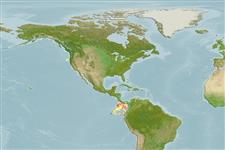Классификация / Names
народные названия | синонимы | Catalog of Fishes(род, виды) | ITIS | CoL | WoRMS | Cloffa
>
Ophidiiformes (Cusk eels) >
Ophidiidae (Cusk-eels) > Neobythitinae
Etymology: Porogadus: Greek, poros = porous + Latin, gadus = a fish, cod? (Ref. 45335).
More on author: Garman.
Environment: milieu / climate zone / depth range / distribution range
экология
морской батидемерсальный; пределы глубины 245 - 3300 m (Ref. 125143), usually 1800 - 3300 m (Ref. 125143). Deep-water; 10°N - 0° (Ref. 125143)
Eastern Pacific.
Size / Вес / Возраст
Maturity: Lm ? range ? - ? cm
Max length : 46.5 cm SL самец/пол неопределен; (Ref. 125143)
Краткое описание
определительные ключи | морфология | морфометрия
This species is distinguished by the following characters: precaudal vertebrae 17-19; lower first gill arch with long gill rakers 11-13; pectoral-fin rays 19-22; HL:HD 1.81-2.08; in small specimens, head spines strong, while in in large specimens short and poorly extruding, present on ethmoidal, lacrimal, prefrontal (weak), interorbital (weak), supraorbital (weak in large specimens), sphenotic, 5th infraorbital, supratemporal (absent in large specimens), inner and outer posttemporal (absent in large specimens), inner and outer preopercular rims (absent in large specimens); opercular spine is sharp, strong, extruding; maxilla with no or few scales at rear; lower lateral line pores until beginning of anal fin 22-24; vomer with a broad dentition patch
(3-9 rows of teeth); palatines with broad dentition patch (2-11 rows of teeth); otolith with separate ostial and caudal colliculi indicated by ventral incision; OL:OH = 1.75-2.1; OL:TCL = 1.8-1.9 (Ref. 125143).
Rare species (Ref. 34024). This species ventures out for about 800 km from the continental break and occurs primarily between 1800 and 3300 m but two specimens were caught in very shallow water at 245 m or near the surface. The reason for the unusual shallow catches are not known (Ref. 125143). Reproductive strategy possibly similar to other members of this family featuring oviparity, with oval pelagic eggs floating in a gelatinous mass (Ref. 205).
Life cycle and mating behavior
Maturities | размножение | Spawnings | Egg(s) | Fecundities | личинки
Schwarzhans, W.W. and P.R. Møller, 2021. Revision of the ‘dragon-head’ cusk eels of the genus Porogadus (Teleostei: Ophidiidae), with description of eight new species and one new genus. Zootaxa 5029(1):001-096. (Ref. 125143)
Статус Красного Списка МСОП (Ref. 130435)
Угроза для людей
Harmless
Использование человеком
рыболовство: интереса не представляет
дополнительная информация
инструменты
Специальные отчеты
Скачать в формате XML
ресурсы в Интернет
Estimates based on models
Preferred temperature (Ref.
123201): 2.6 - 3.1, mean 2.7 °C (based on 6 cells).
Phylogenetic diversity index (Ref.
82804): PD
50 = 0.5001 [Uniqueness, from 0.5 = low to 2.0 = high].
Bayesian length-weight: a=0.00380 (0.00165 - 0.00876), b=3.14 (2.93 - 3.35), in cm total length, based on LWR estimates for this (Sub)family-body shape (Ref.
93245).
Trophic level (Ref.
69278): 3.7 ±0.6 se; based on size and trophs of closest relatives
устойчивость к внешним воздействиям (Ref.
120179): средний (среднего размера), минимальное время удвоения популяции 1.4-4.4 года (Preliminary K or Fecundity.).
Fishing Vulnerability (Ref.
59153): Moderate vulnerability (43 of 100).
